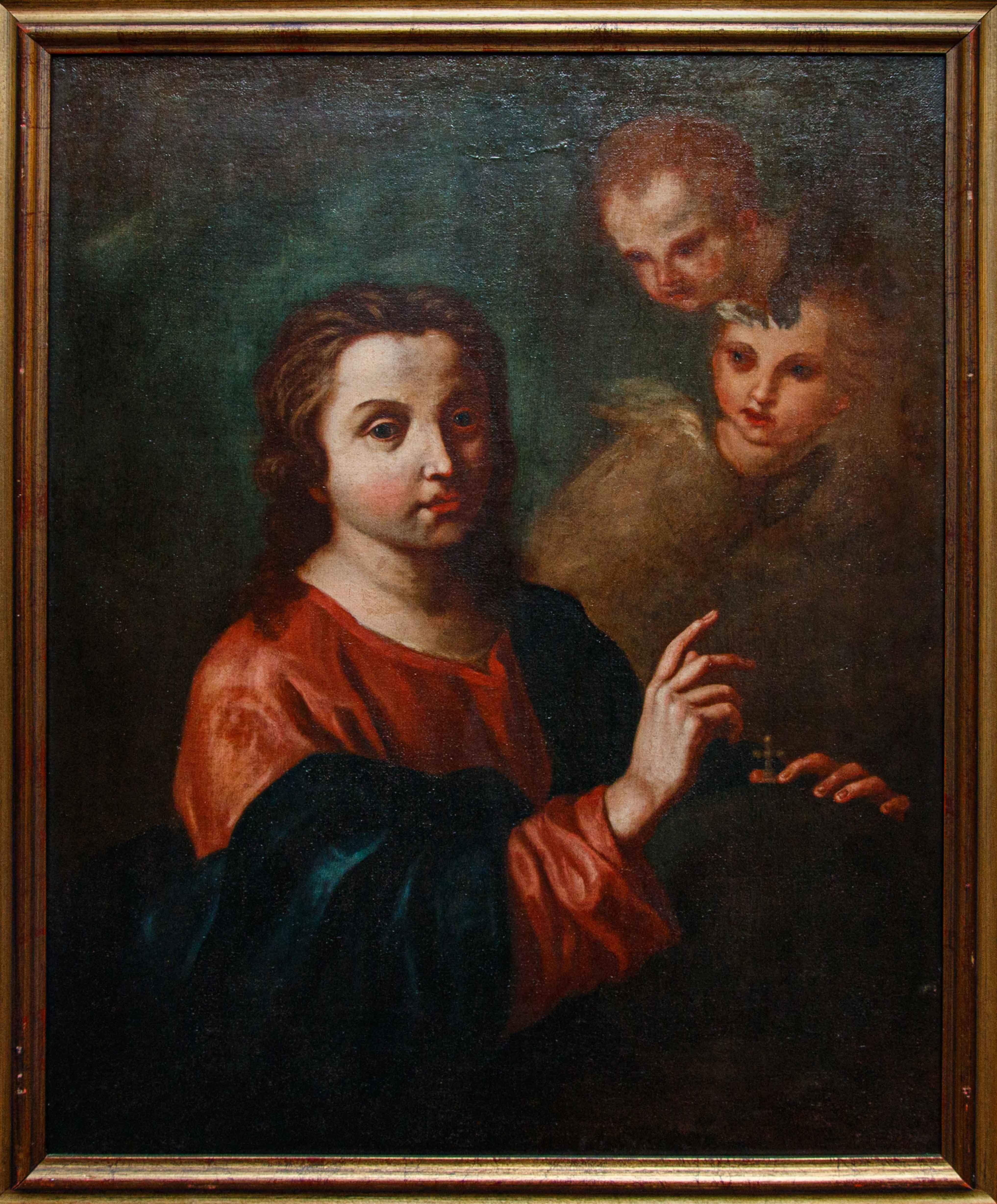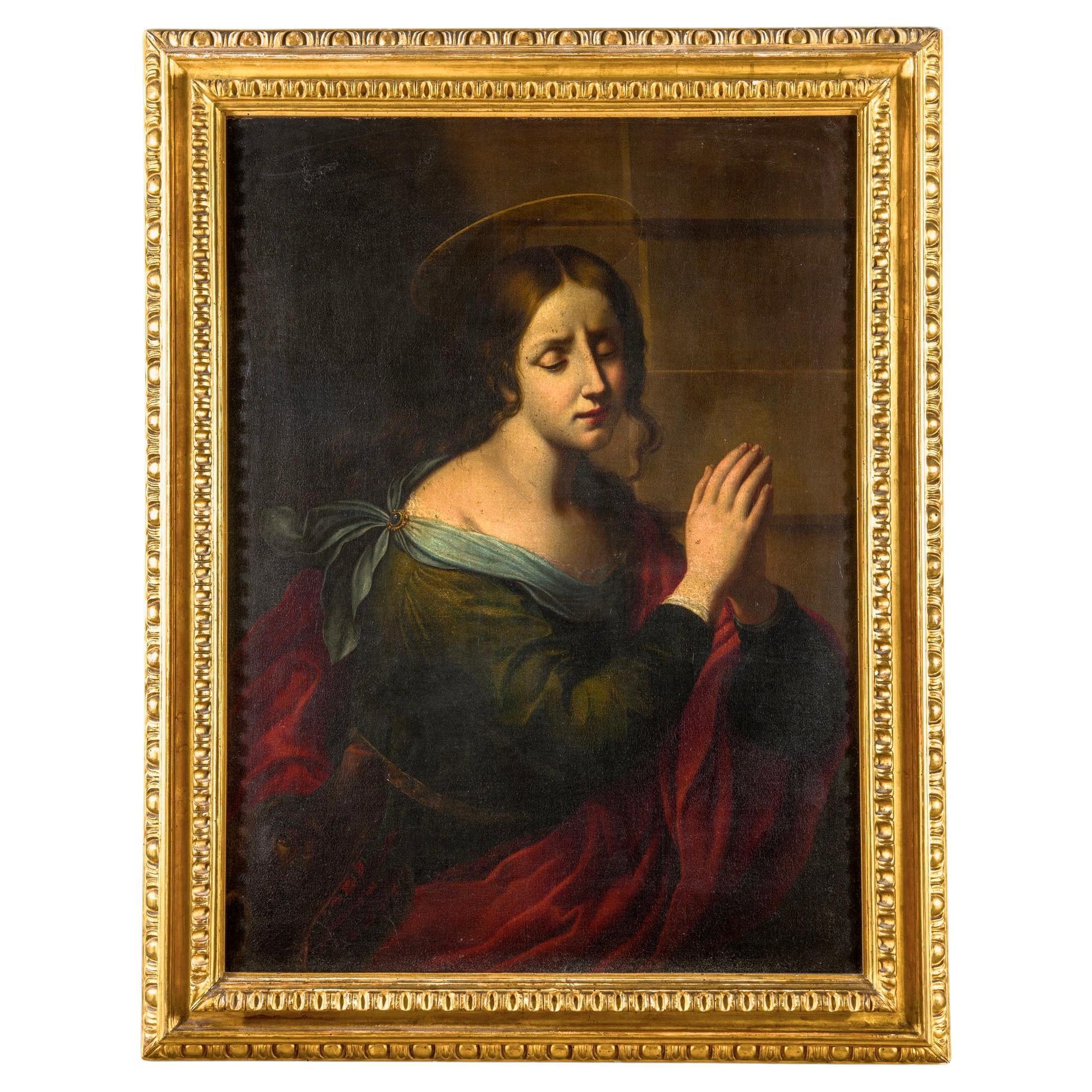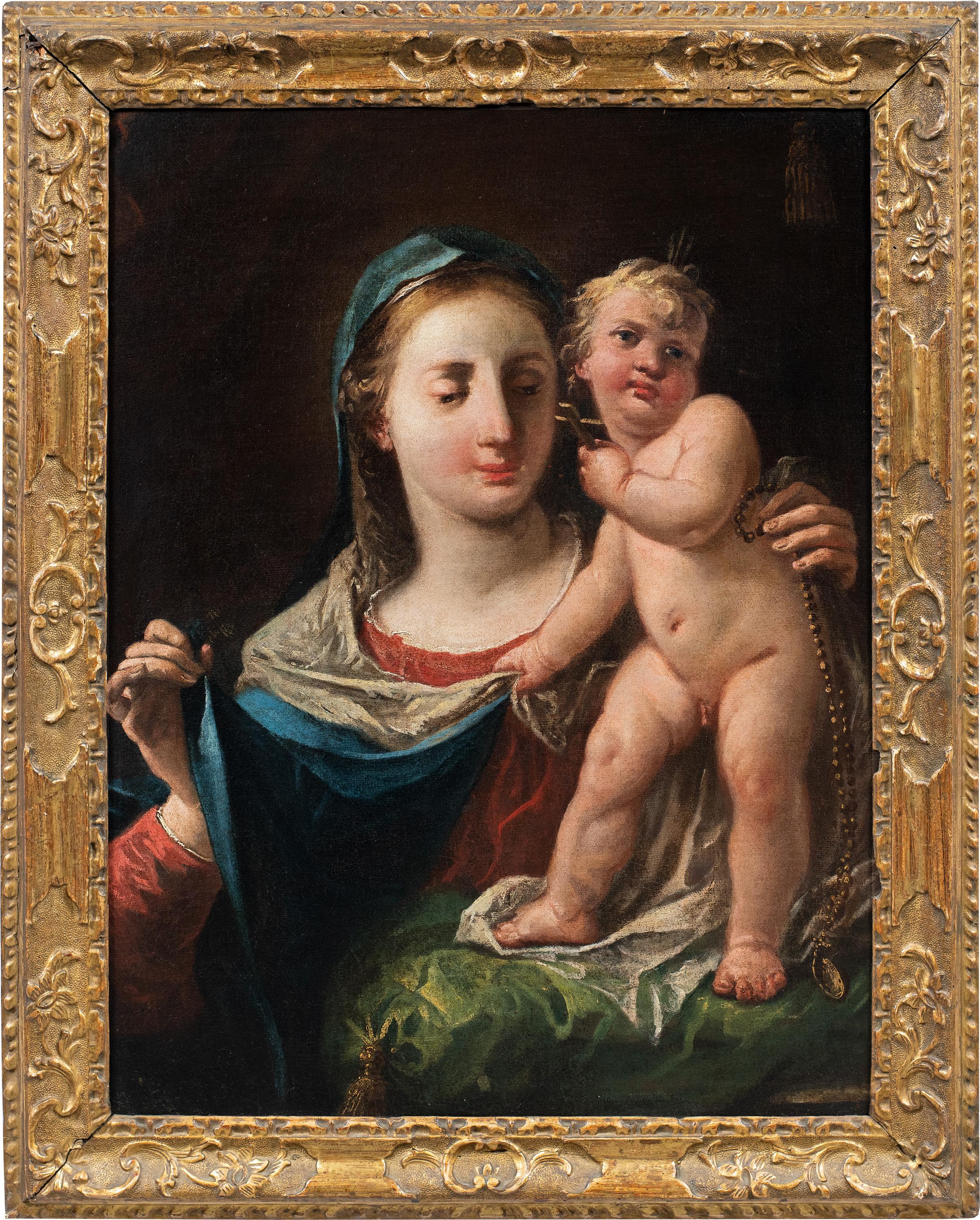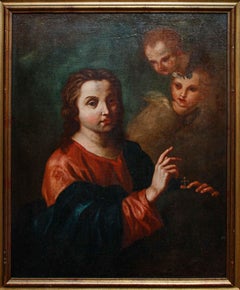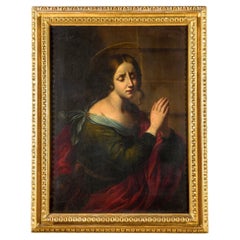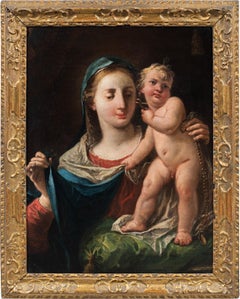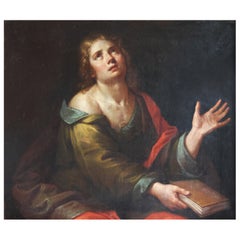Items Similar to Giuseppe Nuvolone (Milan, 1619 - 1703), Saint in Ecstasy
Want more images or videos?
Request additional images or videos from the seller
1 of 15
UnknownGiuseppe Nuvolone (Milan, 1619 - 1703), Saint in EcstasyXVII Century
XVII Century
$11,937.64
£8,794.82
€10,000
CA$16,430.08
A$18,231.61
CHF 9,616.73
MX$222,569
NOK 121,670.40
SEK 113,954.17
DKK 76,120.67
About the Item
Giuseppe Nuvolone (Milan, 1619 - 1703)
Saint in ecstasy
Oil on canvas, 97 x 73 cm
Framed, 113 x 90 cm
Provenance: Rome, private collection
The second son of the famous painter Panfilo and his consort Isabella, Giuseppe Nuvolone was born in 1619 in Milan. Like his brother Charles Francis, he was often remembered in contemporary and later documents by the nickname of his father Panfilo. We do not have well-defined information with respect to his beginnings as a painter and his training, which must have taken place, however, with his older brother Charles Francis. This is evidenced by the earliest works that can be referred to him with certainty, namely the Domestic Works of the Holy Family in S. Giorgio in Bregnano (1646) and the altarpiece with St. Francis in Ecstasy in S. Giorgio in Cornate d'Adda (1650), in which he demonstrates an unconditional adherence to the style choices of the fraternal workshop, so much so that, especially in these years, the distinction between the works of the two painters and the precise definition of their respective catalogs are often problematic. The contiguity with his brother is confirmed in the numerous undertakings executed in collaboration, starting at least with the cycle of canvases and frescoes with Biblical Scenes in the Chapel of the Savior of the Sanctuary of the Blessed Virgin of Vimercate (1648-1652) and the famous Self-portrait of the Nuvolone family in the Pinacoteca di Brera, made around mid-century, in which Giuseppe is responsible for the three figures on either side of the scene, including the self-portrait, in the act of playing a mandola. Focusing on the role played by Giuseppe in the context of this long habit of collaboration finds an indispensable term of reference in the paintings made in the same years by the painter independently, such as the decoration of the chapel of S. Antonio Abate in the collegiate church of S. Lorenzo in Chiavenna, whose altarpiece bears the date 1657; the altarpiece in the parish of Groppello d'Adda (1657); the Magdalene in the Museo civico in Novara (1655-1658); and the Cain and Abel in the basilica of S. Maria Maggiore in Bergamo, dated 1659. Compared with the works of his brother Charles Francis, Giuseppe's corpus is distinguished by a marked propensity to characterize the figures more vigorously and to introduce more explicit expressive accentuations into the delicate typological repertoire of the family workshop, which contribute to cracking the harmonious regularity of the faces. These stylistic prerogatives are also fully grasped in Joseph's slightly later works, such as the large Madonna of Milk and Devotees, formerly at the antiquarian Luzzetti in Florence (1661) and Ruth and Boaz, from a private collection (1662): two paintings also useful in highlighting the narrative effectiveness of Joseph's painting and his ability to master large-scale representations. It is also by virtue of these qualities that the artist enjoyed, starting in those years, a growing success, certainly favored by the death of Carlo Francesco in 1661, which turned him into the main popularizer of the fortunate 'Nuvolonian' manner: the painter's growing popularity translated into a noticeable increase in illustrious commissions, such as those received from the Savoy family or the noble Bartolomeo Arese, who became president of the Senate of Milan in 1660. Participation in the lost series of canvases commissioned for the funeral of King Philip IV in Milan cathedral (1665) and the execution of the Habsburg Allegory now in Milan's Palazzo Sormani, which has been proposed to be related to the ceremonies prompted by the passage to the Lombard capital in 1666 of Margaret of Austria, future wife of Emperor Leopold I, should be read in this light. Between the 1660s and the 1970s Giuseppe Nuvolone sojourned in Rome and worked in various Lombard centers, first and foremost Cremona, the birthplace of his father Panfilo, and Brescia. Giuseppe's extensive and successful career ended with his death in 1703; the painter passed on his profession to his sons Carlo, who was active mainly in the Swiss area, Gerolamo and Antonio.
The depiction of female figures in an ecstatic state turns out to be frequent with regard to the entire pictorial production of the Nuvolone family and is channeled in a vein variously traversed, as early as the first quarter of the seventeenth century, by the so-called Lombard pestants: we need only think, in this perspective, of the evocative works of Francesco Del Cairo. This typology occurs often in Joseph's production, as denoted by the Martyr Saint of the Carrara Academy in Bergamo and the Saint Lucy pertaining to the municipality of Brescia. The figure of our saint, probably identifiable with Margaret of Antioch, with the peculiar hairstyle enriched with pearls and holding in her hands the palm of martyrdom, rendered with soft sensuality, finds palm comparisons in some of Giuseppe Nuvolone's works, among which we recall, in addition to the already mentioned canvases of Bergamo and Brescia, Magdalene comforted by an angel (formerly Finarte, Rome 1984, cf. Ferro, 2003, p. 426 no. 108b) or two different versions of Saint Ursula (location unknown, Ferro, 2003, p.426, no, no. 108d and private collection, Ferro, 2003, p. 427, no. 109c). Also very similar in terms of pictorial conduction, pose and workmanship of the robes is the figure of St. Catherine in the altarpiece of St. Catherine and St. Francis Xavier made by Giuseppe Nuvolone for the Company of Merchants of Oleggio (Novara) and now preserved in the parish church.
- Creation Year:XVII Century
- Dimensions:Height: 38.19 in (97 cm)Width: 28.75 in (73 cm)
- More Editions & Sizes:cm 97 x 73Price: $11,938
- Medium:
- Period:
- Condition:
- Gallery Location:Milan, IT
- Reference Number:1stDibs: LU2639216763982
About the Seller
No Reviews Yet
Vetted Professional Seller
Every seller passes strict standards for authenticity and reliability
1stDibs seller since 2023
Typical response time: <1 hour
- ShippingRetrieving quote...Shipping from: Milan, Italy
- Return Policy
Authenticity Guarantee
In the unlikely event there’s an issue with an item’s authenticity, contact us within 1 year for a full refund. DetailsMoney-Back Guarantee
If your item is not as described, is damaged in transit, or does not arrive, contact us within 7 days for a full refund. Details24-Hour Cancellation
You have a 24-hour grace period in which to reconsider your purchase, with no questions asked.Vetted Professional Sellers
Our world-class sellers must adhere to strict standards for service and quality, maintaining the integrity of our listings.Price-Match Guarantee
If you find that a seller listed the same item for a lower price elsewhere, we’ll match it.Trusted Global Delivery
Our best-in-class carrier network provides specialized shipping options worldwide, including custom delivery.More From This Seller
View AllCircle of Giovan Battista Piazzetta (1683-1754), Christ Salvator Mundi
By Giovanni Battista Piazzetta
Located in Milan, IT
Circle of Giovan Battista Piazzetta (1683-1754), 18th century
Christ the Savior Mundi
Oil on canvas, 81 x 64 cm
Framed, 90 x 72 cm
This painting is configured within the eighteen...
Category
Early 18th Century Other Art Style Figurative Paintings
Materials
Canvas, Oil
Assunzione della Vergine Dipinto di Giovanni Coli e Filippo Gherardi
Located in Milan, IT
Giovanni Coli (San Quirico, 1636 - Lucca, 1681), Filippo Gherardi (Lucca, 1643- 1704)
Assunzione della Vergine
Olio su tela, cm 95 x 70
Con cornice cm 111 x 85
La tela in esame è...
Category
17th Century Figurative Paintings
Materials
Canvas, Paint, Oil
Giovanni Giacomo Sementi (Bologna, 1580 - 1636), Sibyl
Located in Milan, IT
Giovanni Giacomo Sementi (Bologna, 1580 - 1636)
Sibylle
Oil on canvas, 74 x 64 cm
Framed, 93 x 84.5 cm
Oral communication Prof. Massimo Pulini
The painting is not signed
Biblio...
Category
18th Century and Earlier Other Art Style Figurative Paintings
Materials
Canvas, Oil
Paolo De Matteis (Piano Vetrale 1662 - Naples 1728), attr., Dream of Joseph
By Paolo de Matteis
Located in Milan, IT
Paolo De Matteis (Piano Vetrale 1662 - Naples 1728), attr.
Joseph's Dream
Oil on canvas, 49 x 65 cm
Antique Roman frame known as "Maratta," of carved and gilded wood, 61 x 76 cm
...
Category
18th Century Other Art Style Figurative Paintings
Materials
Canvas, Oil
Paolo Monaldi (Rome, 1710 - after 1779), attr. , Genre scene
Located in Milan, IT
Paolo Monaldi (Rome, 1710 - after 1779), attr.
Genre scene
Oil on canvas, 28 x 38 cm
Framed, 36.5 x 46 cm
The canvas depicts a moment of repose drawn from the rural world: the...
Category
18th Century and Earlier Other Art Style Figurative Paintings
Materials
Canvas, Oil
Girolamo Maria Pesci (Rome, 1679 - 1759), The judgment of Paris
Located in Milan, IT
Girolamo Maria Pesci (Rome, 1679 - 1759)
The judgment of Paris
c. 1705-1710
Oil on canvas, 47 x 36.5 cm
Girolamo Maria Pesci (Rome, 1679 - 1759), a figure distinguished for his e...
Category
18th Century and Earlier Other Art Style Figurative Paintings
Materials
Canvas, Oil
You May Also Like
17th Century Onorio Marinari Italian Religious Painting
By Onorio Marinari
Located in Roma, IT
A very important painting by the great artist of the Florentine school, Onorio Marinari.
Dr. Silvia Benassai has confirmed Marinari’s authorship of the Saint Margaret of Antioch; ava...
Category
Mid-17th Century Baroque Portrait Paintings
Materials
Canvas, Oil
Gaspare Diziani (Venetian Rococò) - 18th century figure painting - Virgin Child
By Gaspare Diziani
Located in Varmo, IT
Gaspare Diziani (Belluno 1689 – Venice 1767) - Madonna and Child.
74 x 58 cm unframed, 88.5 x 69.5 cm with frame.
Ancient oil painting on canvas, in a carved and gilded wooden fram...
Category
Mid-18th Century Rococo Figurative Paintings
Materials
Canvas, Oil
Michelangelo Merisi Caravaggio manner of; St. John the Evangelist oil on canvas
By Michelangelo Merisi da Caravaggio
Located in Brescia, IT
Description
Michelangelo Merisi da Caravaggio manner of
Milan 1571 - Porto Ercole 1610
Saint John the Evangelist
Oil on canvas
cm 91,5x107
The painting depicts St. John the Evangeli...
Category
Antique Late 17th Century Louis XIV Paintings
Materials
Canvas
Adoration of the Shepherds, c. 1620.
Located in Milan, IT
Oil on Canvas. Venetian school of the 17th century.
Looking to the models popularized by Jacopo Bassano, the painting presents a scene rich in figures and contour elements typical of...
Category
17th Century Other Art Style Figurative Paintings
Materials
Oil
Italian School; Saint Barbara, 18th century, oil on canvas
Located in Brescia, IT
Description
Santa Barbara
Oil on canvas
cm 93x71
The painting depicts St. Barbara, a highly revered Christian saint, especially as the patron saint of miners, gunners and firefighte...
Category
Antique 18th Century Italian Louis XV Paintings
Materials
Canvas
18th Century by Matteo Bonechi Presentation of Jesus Painting Oil on Canvas
Located in Milano, Lombardia
Matteo Bonechi (Florence, Italy, 1669 - Florence, Italy, 1756)
Title: Presentation of Jesus
Medium: Oil on canvas
Dimensions: without frame 75 x 49 cm – with frame 89.5 x 65 cm
Shaped, carved and gilded wooden box frame
Expertise by Sandro Bellesi, Professor and art historian
Fairs: The International Biennial of Antiques in Florence 2022 (BIAF, Biennale Internazionale dell’Antiquariato di Firenze)
Publications: Bozzetti, modelletti, sketches: dalla collezione di Giorgio Baratti (From the Giorgio Baratti Collection) curated by Anna Orlando, Agnese Marengo and Annalisa Scarpa, Genova, 2022, pp. 20, 21.
The present painting is a very interesting testimony of the creative process of Matteo Bonechi, one of the leading artists on the Tuscan art scene in the early 18th century. The canvas in question is in fact the last preparatory model made by Bonechi before he executed an altarpiece for the church of San Filippo Neri in Cortona in 1716. The scene presented here is that of the Presentation of Jesus, when, forty days after his birth, the child is ransomed through an offering in the temple and placed in the hands of Simeon, who prophesies his future: the coming of the Messiah...
Category
Early 18th Century Old Masters Figurative Paintings
Materials
Oil, Canvas
